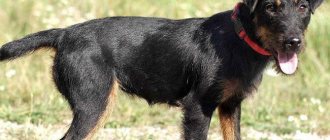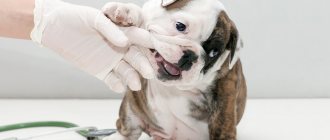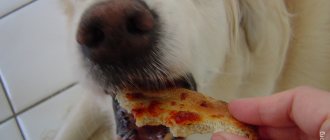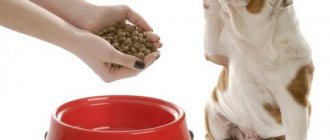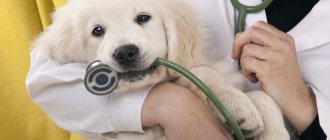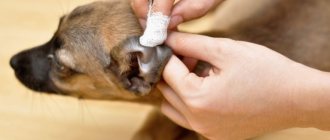Every owner has heard about a natural indicator of the well-being of pets. Contrary to popular belief, unusual dryness and heat do not always indicate pathology. If a dog has a dry and warm nose, then the cause of such changes may be non-hazardous natural factors. This is easy to understand with the help of accompanying symptoms that appear when your health worsens.
What should a healthy dog's nose look like?
If the dog is healthy, then the tip of his nose is moderately moist and cool. The mucous membrane of the lobes remains pale pink when at rest and changes color intensity to pinkish-red when excited. On a dark nose, color changes are invisible.
The appearance of cracks and dryness indicates a limitation or complete loss of functionality of the wetting glands. Over time, this leads to swelling of the mucosa, the formation of ulcers and crusts.
Physiology of the dog's nose
The sensitivity of a dog's sense of smell is explained by the unusual structure of the organ. Unlike a human's, a dog's nose is equipped with four holes: front and side. This structure eliminates the mixing of odors. Inhaled air enters through the nostrils, and exhaled air exits through holes located on the sides.
Another feature is the mucous film covering the outer and inner surfaces of the olfactory organ. It not only increases sensitivity, but also performs an antibacterial function.
A New Look at a Dog's Nose
A dog's nose holds many secrets. Few people know that our dogs’ noses contain an unusual organ, the vomeronasal organ, which plays a key role in many important behavioral responses. In this article I will try to lift the veil of secrecy that shrouds him.
Where is it located and what does it look like?
Scientists consider the vomeronasal organ (also known as Jacobson's organ, vomer) as part of the olfactory system, in which it is responsible for detecting pheromones (1). In dogs, the vomer consists of a pair of elongated bags filled with liquid secretions, which are located in the front part of the palate. Their ducts open into the oral cavity immediately behind the incisors (3.7). The cavity of these bags is lined with olfactory epithelial cells (cells whose main function is the perception of odors) (4).
VNO - vomeronasal organ. Schematic layout
Tonguing
It is difficult to find at least one person who has not seen a horse “smile”. At the same time, she raises her head, stretches her neck, lifts her nose up and funny curls her upper lip towards her nostrils (2). This movement is called flehmen, or “testing”: the horse touches the mark of another horse with its upper lip, inhales, and odor particles from the upper lip are drawn into the nostrils along with the air. In horses, unlike dogs, the ducts of the vomeronasal organ lead to the nasal cavity (2). Dogs also have flemen. In English-language sources it is sometimes called the term tonguing (10). It looks like this. The dog touches the mark or loop of another dog with the tip of its tongue, chatters its teeth, tenses its lips, slightly bulging its eyes. In this case, strong salivation may begin and foam may appear. Teeth chattering most likely occurs because the dog needs to touch the ducts leading into the vomer, located just behind the incisors, with the tip of the tongue. But since the tongue of dogs is not as flexible as that of humans, and our pets cannot curl it by touching the palate with only its tip, they simply very quickly close and open their mouth, while slightly sucking the smell from the tongue into the vomeronasal organ. Hence the bulging eyes and tense, drawn-in lips. Tonging is observed not only when testing a urine mark, but also, for example, when testing the air during an exchange of mutual threats between two rival males. When two males separate, they may raise their noses higher, inhale rhythmically and make tonging movements. In addition, tonging is often observed in bitches during estrus, while mark testing by tonging may not be observed at all other times (10).
Where is the information from the vomer “sent”?
The vomeronasal organ detects pheromones. Pheromones are volatile substances released by the body into the external environment, with the help of which animals of the same species can exchange information with each other (about gender, hormonal status, physical condition, etc.). Pheromones can be either single odors or mixtures of them of varying complexity. (6). Scientists were able to establish that the vomeronasal organ is involved in various aspects of an animal’s life: from intraspecific aggression to sexual and maternal behavior. It seems absolutely amazing that such a small body should have so much power. The thing is that the vomeronasal organ transmits information to the hypothalamus, a part of the brain that is responsible for many functions, one of which is the control of the hormonal state of the body. This is where the signals that the dog receives come from examining marks using the vomeronasal organ (7, 8). That is, through this organ, some odors directly affect the hormonal state of the body. Moreover, the development of some forms and elements of behavior is so dependent on odors that if a dog’s vomeronasal organ is removed at an early age, then this behavior will never appear again (for example, a mother’s attachment to her cub will not form, a male may not recognize a female in estrus ) (6).
Individual recognition.
One of the main functions performed by the vomeronasal organ is
individual recognition by scent mark. So, for example, three dogs may have a signal that is identical in composition (set of components), but at the same time different in their quantitative ratio in the secret. And thus, each of them will have its own individual smell that distinguishes it. But it should be noted that Most of the secrets and excreta that are used by mammals to transmit information to each other about themselves and their condition consist of a mixture of a huge number of components (6). Scent exchange plays a critical role in territorial behavior. In addition, scientists believe that by using the mark, a dog can determine not only whether a familiar dog left a scent, but also, if it is a stranger, the gender and size of the competitor, and even its diet (5).
Sexual behavior.
The vomeronasal organ plays one of the leading roles in the sexual behavior of dogs. With the help of a vomer, a male can not only detect and find a female that interests him by following the trail, but even determine the moment of her ovulation (5). Thus, scientists have discovered that during the breeding season, captive wolves of lower rank can mount females in heat without the intervention of the main, dominant male. But this “chaos” lasts only until the alpha male detects the presence of a specific pheromone - methylparaben. After he smells the pheromone, he does not allow a single male to approach his females, fiercely defending his superiority. Moreover, applying this substance to the loop of a sterile female caused excitement and active mating on the part of the males. It is worth noting that the effect produced by this substance on dogs is identical to the effect it produces on wolves. This substance is included in some perfumes. Dogs react to him like wolves - they get excited and attack... a person (9). With experience, male dogs can distinguish not only females in heat by smell, but also the moment of ovulation. Thus, many breeders report that their male dogs, after some time, get used to the estrus of the kennel’s bitches and tolerate them calmly, beginning to be interested in their female friends only on those days when ovulation occurs (6). The ability of male dogs to get used to the smell of a bitch in heat is used at training grounds. Some instructors conduct classes with male dogs in the presence of females in heat, which subsequently leads to the males becoming accustomed to the smell.
Maternal behavior.
We must also not forget about another important role of the vomeronasal organ in the life of females and cubs - the formation of mutual affection between mother and baby. Thus, female mice whose vomeronasal organ was removed did not form attachments to their pups. No such experiments have been carried out on dogs, but it is possible that for them, too, the vomeronasal organ plays an important role in establishing contact between the parent and the young (5, 6). It is for this reason that you should not dry or wash newborn puppies. It is worth allowing the female to lick her babies, because this helps the formation of attachment and the launch of maternal behavior!
A horse licks its newborn foal and demonstrates flemen - this is one of the most important stages for the formation of attachment between mother and (f)child
Golden Key
The importance of the role of the vomeronasal organ in the behavior of our dogs is hard to deny. Its close relationship with the hormonal system, and therefore its significant contribution to the triggering of powerful behavioral responses, is what makes the vomeronasal organ key to understanding many physiological and behavioral responses. Well, knowledge, in turn, gives us the ability to avoid many mistakes and achieve maximum results.
Literature:
1. Afanasyev Yu.I., Yurina N.A., Kotovsky E.F. Histology. – M.: Medicine, 2002 2. Baskina S. What a horse thinks about and how to learn to understand it. – M.: Aquarium-Print, 2008 3. Kruchenkova E.P. Maternal behavior of mammals. — M.: KRASAND 2009 4. Correa, Julio E. The Dog's Sense of Smell // Alabama Cooperative Extension System, July 2005. (May 24, 2011) 5. Dawley E. Species, sex, and seasonal differences in VNO size / / Microscopy Research and Technigue, - 1998, Vol. 41, pp. 506-518 6. Johnston R. Pheromones, the vomeronasal system, and communication. From hormonal responses to individual recognition // Annals New York Academy of Sciences, - 1998, Vol. 855, P. 333-348 7. Keverne E. The vomeronasal organ // Science, - 1999, Vol. 286, P. 716-720 8.Kimball JW Pheromones // Kimball's Biology Pages - Sep 2008 https://users.rcn.com/jkimball.ma.ultranet/BiologyPages/P/Pheromones.html 9. Mertens PA Reproductive and sexual behavioral problems in dogs // Theriogenology. 2006 Vol. 66. P. 606–609 10. https://cynologist.com/index.php/anatomy-of-dog/sensory-abilities-vomeronasal-organ
Non-dangerous causes of a dry and warm nose in a dog
If the puppy has a dry and warm nose, then his first teeth or molars may erupt. After the full combat kit appears, the baby’s condition should return to normal.
A predisposition to poor mucus production, inherent from birth, is also not a cause for concern. This anomaly is inherited and is not considered a dangerous abnormality.
In the absence of pathology, the unusual condition covers a short period of time and is not accompanied by other alarming symptoms. A healthy dog remains active and eats with the same appetite.
Dream
The mucous membranes dry out and heat up during sleep, since at this moment all processes slow down. The usual humidity returns some time after waking up.
Fatigue
Increased physical activity takes a lot of energy. If your pet has recently been running with other animals or following complex commands, then he needs a little break.
Overexcitement
An increase in the temperature of a dog's nose indicates internal distress. Having recovered from fright or excessive joy at the sight of the owner, the pet will definitely return to normal.
Hot weather
Never leave a defenseless pet under the scorching sun. Prolonged exposure to heat can lead to heatstroke or sunstroke.
Frosty weather is no less dangerous. Cold combined with strong wind quickly dries out the mucous membrane, leading to its cracking.
Dryness in the apartment
During the heating season, the air in the apartment becomes too dry. Due to the lack of moisture, the skin constantly dries out and cracks, causing unpleasant consequences for four-legged pets and their owners. In such cases, buying an air humidifier can help.
Pregnancy and childbirth
Another possible reason is hormonal imbalance. It occurs during pregnancy, childbirth, lactation and estrus.
Anatomy of a dog's nose and the secret of its moisture
A dog’s nose really should be constantly wet – and that’s why it should be cold . The secret of this feature of the animal’s body is that the skin on the dog’s nose is capable of secreting mucus - it has special glands, just like the mucous membrane inside the nasal cavity. Moisture of the nose is important for the dog, due to it it is possible to more effectively distinguish and identify odors, as well as the directions from which they come.
Dog nose
Fun fact : To determine the direction of the wind, a person can hold a finger in their mouth to moisten it and then lift it to feel the blow on their own skin.
Wet nose and sense of smell
The wet surface of the body actually becomes more sensitive in this regard. But this reason is not the only one that explains the wetness of a dog’s nose. It is also worth noting that the wet layer above the skin functions like a gas-liquid chromatograph, because the difference in the speed of molecules of substances that emit odor is recognized, and the dog can determine the directions and proximity of objects even better.
Interesting: Owl

